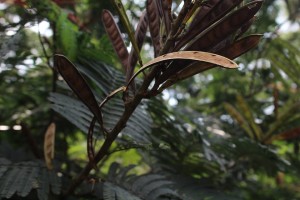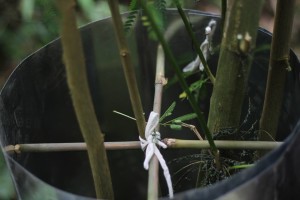The dry season is nearly here, and all of the Calliandra calothrysus seeds are beginning to disperse! One third of the loris diet in Cipaganti is consumed from Calliandra calothrysus—a legume species, commonly known as ‘fairy dusters’, or locally known as ‘kaliandra merah’ in Indonesian. There are two types of kaliandra here—kaliandra merah (red flowers) and kaliandra putih (white flowers). Both species are on different phenology cycles, so they are blooming flower and fruit at different times of the year. Right now, all of the kaliandra merah seed pods are beginning to pop open, shooting their seeds out at a distance with this unique evolutionary adaptation to improve seed dispersal. It almost sounds like popcorn popping around you in the forest watching the lorises at night. Lorises regularly use both species of kaliandra to travel, forage for insects, and play and socialize with other lorises, but they only feed on the floral nectars from kaliandra merah.

This topic caught my interest in 2013, and I’ve been dying to look more into the topic. I want to know why lorises only feed from the kaliandra merah, what the energetic rewards of the nectar are for lorises, if lorises are pollinators of this species, and how an invasive species introduced circa 50 years ago can be so ecologically fitting. Calliandra is not native to Java. It’s a legume that originates from South and Central America. Farmers discovered it could benefit their farm soils and crop yields, as well as provide feed for their livestock. But how is such a new species thriving so well across Java?
In order to try and solve this question, I have been focusing much of my time on these legume species – not just observing their relationship with lorises, but all mammals, bird, bats and insects as well. I want to identify all species that interact with them to try and determine who pollinates it and which environments they thrive in to allow this ecological fit.
In addition to detailed behavioural data on loris interactions with the tree (and I’ve previously described to you the all-night ‘tree follows’ I was conducting to determine what nocturnal species feed on them), I am also conducting all-day ‘tree follows’ with our entomologist, Albie. With Albie’s help, he can identify what species of insect are feeding or foraging on the kaliandra. Meanwhile, I regularly taking nectar, fruit and seed samples from these trees to measure what energetic rewards these inflorescences have to offer. Checking the phenology of these trees every other week (measuring the stage and quantity of flower and fruit) also helps us to see when they produce food for lorises and other species.
And finally, these are the pollination control plots. In one of my earlier blogs, I talked about the pollination bags and pollination boxes that myself and Adin had built and set up around kaliandra merah. These work to control who can/can’t pollinate flowers of a given tree. The bags prevent any species from pollinating, and test for self or wind pollination; the pollination boxes have a larger netting around them to allow insects to feed on the flowers, but prohibit bat, bird or mammals from accessing them; and now, we’ve created isolated trees, to test if non-flying animals are significant pollinators.
We searched for kaliandra trees that had no connectivity to other trees, and then created an aluminium barrier around the trunk that mammals couldn’t grip to climb. We check each of these pollination plots every other week, taking data on the tree phenology – so we can measure the influence these different controls have. From this, we can deduct who is a significant pollinator, and what ecosystem type kaliandra benefits in.

So how does this benefit the lorises? Lorises are very often found in agroforest areas. This puts them both at risk of fragmentation and the human-primate interface (when humans and primates live in the same area, often putting them at risk of disease and hunting for the pet trade). Since kaliandra has been proven to be beneficial for farmers (as it enhances their soils) we can then provide education in the area both about the importance of lorises remaining in the forest, and how kaliandra can benefit their farming practices. Then, not only will lorises be left to live in the wild, but they will also have plenty of kaliandra to feed on, in their preferred habitats. This is a good example of our different branches of research at LFP all overlapping to help loris conservation—education, behaviour, ecology and agroforestry.
- Katie Reinhardt, PhD Researcher
